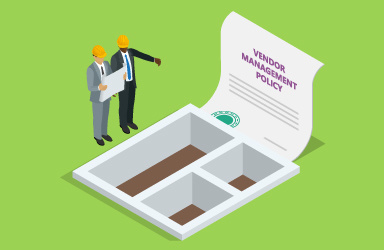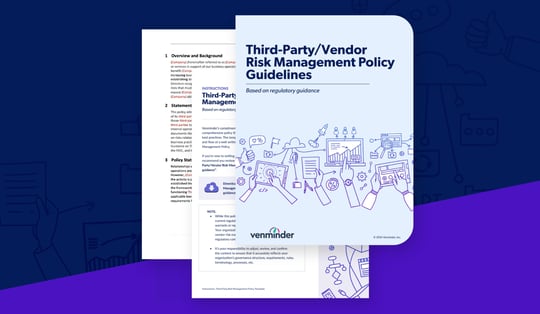Do you remember the classic childhood nursery rhyme The Three Little Pigs? As a quick refresher, in the story there are three pigs building homes. Each one is using a different material –straw, sticks or brick. There is a big bad wolf who comes around and tries to blow each pigs’ home down. In the end, the only one left standing is the one made of brick. The house made of brick is the only one with a solid enough foundation to withstand the wolf.
You see, I think about this story when I think about the importance of a solid vendor management policy. A comprehensive vendor management policy is the foundation of a strong vendor management program as the vendor management policy is really where it all begins. You can’t have a healthy vendor management program without a thought-out policy.
What Is a Vendor Management Policy?
A vendor management policy is a high-level document that’s instructive to senior management and the board about the activities completed in the vendor management program.
If the vendor management policy is thrown together without care or is a poor-quality document, it won’t survive a regulator or examiner review. The entire program will come crumbling down and you’ll be back to square one. It really is that important.
5 Ways Your Vendor Management Policy Lays the Foundation for Your Program
Here are five ways your policy lays the foundation:
- It’s your framework. The policy is the framework of how vendor management will be handled at your organization.
- It’s your first step before drafting important supporting documentation. The program and procedures documents are supporting components that build on the policy. You must have a policy in place before you can properly draft the program and procedures. It’s a three-step process.
- It outlines your program’s purpose. By creating a policy, you’re establishing the standards your organization will follow to adequately manage vendors. Within the policy, you should also cite appropriate regulatory guidance.
- It’s a great resource to look at during an internal audit. Periodically, your internal audit team should review your program to ensure what you say you do meets practice. To guide them, they’ll turn to the policy.
- It addresses the six pillars of vendor management. A well-written policy should address the six pillars of vendor management which are selecting a vendor, risk assessment, contractual standards, due diligence, reporting and ongoing monitoring. Covering each of these areas is essential to a strong program and helps everyone understand how the vendors will be managed throughout the entire vendor lifecycle.
Now that you understand why it all begins with your vendor management policy, you may be curious where to start.
3 Tips to Help You Start Your Vendor Management Policy
Here are three tips to help get you started:
- The policy is a high-level document; therefore, 5-6 pages in length usually suffices.
- The policy should be reviewed and updated at least annually but more as industry guidance changes or if a significant change takes place at your organization.
- Typically, the policy is structured as follows:
- Statement of Policy
- Statement of Purpose
- Risk Management Process
- Assessment of Risk Posed by Third Parties
- Due Diligence
- Contractual Standards
- Oversight and Ongoing Monitoring
- Accountability
As you create your policy, be sure to assign one person who is designated as the final author of the document. However, it’s still good to hear others’ input throughout the development of your policy.
The policy is one of the most beneficial assets to your vendor management program and you want to make sure it’s concise, accurate, informative and sets tone from the top.

















